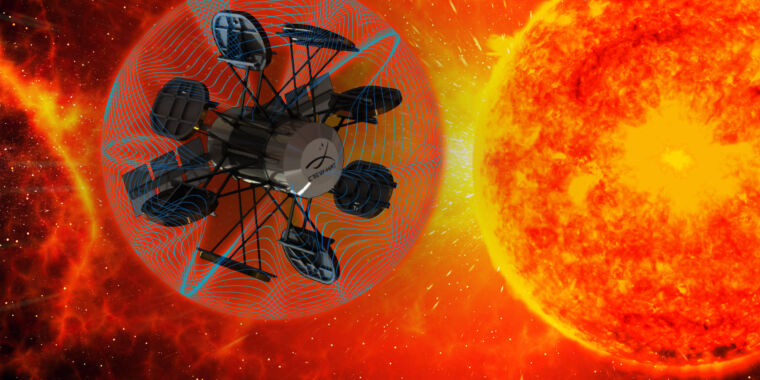Urich Lawson | Getty Images | NASA
On October 19, 1989, at 12:29 UTC, a massive solar flare of class X13 created a geomagnetic storm so powerful that the aurora borealis lit up the skies in Japan, America, Australia, and even Germany the next day. If you had been flying around the moon at that time, you would have absorbed more than 6 sieverts of radiation, a dose that would likely kill you within a month or so.
That's why the Orion spacecraft, which is supposed to take humans on a flyby mission this year, has a highly protected storm shelter for the crew. But such shelters are not enough for a trip to Mars, as Orion's shield is designed for a 30-day mission.
Obtaining protection similar to that we have on Earth would require hundreds of tons of material, and this is simply not possible in orbit. The basic alternative—using active shields that deflect charged particles just as the Earth's magnetic field does—was first proposed in the 1960s. Today, we're finally close to making it work.
Deep space radiation
Space radiation comes in two different flavors. Solar events such as flares or coronal mass ejections can cause very high fluxes of charged particles (mostly protons). They're bad when you don't have shelter but are relatively easy to protect against since solar protons are mostly low energy. The majority of solar particle event fluxes are between 30 MeV to 100 MeV and can be stopped by Orion-like shelters.
Then there are galactic cosmic rays: particles coming from outside the solar system, driven by distant supernovas or neutron stars. These are relatively rare but they come at you all the time from all directions. They also have high energies, starting at 200 MeV and going up to several GeV, making them highly penetrating. Thick blocks do not provide much protection against it. When high-energy cosmic ray particles collide with thin shields, they produce so many low-energy particles, it would be better to have no shield at all.
Particles with energy between 70 and 500 MeV are responsible for 95% of the radiation dose astronauts receive in space. On short flights, solar storms are the main concern because they can be very violent and cause a lot of damage very quickly. However, the longer you fly, the more problematic GCRs become because their doses build up over time, and they can pass through almost anything we try to put in their way.
What keeps us safe at home
The reason why almost none of this radiation reaches us is that the Earth has a natural, multi-stage protection system. It starts with its magnetic field, which deflects most incoming particles toward the poles. A charged particle in a magnetic field follows a curve, the stronger the field, the tighter the curve. The Earth's magnetic field is very weak and hardly bends incoming particles, but it is huge and extends thousands of kilometers into space.
Anything that makes it through the magnetic field extends into the atmosphere, which, when it comes to protection, is equivalent to a 3-metre-thick aluminum wall. Finally, there's the planet itself, which cuts radiation in half since you always have 6.5 billion trillion tons of rock shielding you from the bottom.
To put that into perspective, the Apollo crew module had an average of 5 grams of mass per square centimeter standing between the crew and the radiation. A typical ISS module contains twice that, about 10 g/cm2. Orion's shelter weighs 35-45 g/cm2, depending on exactly where you sit, and weighs 36 tons. On Earth, the atmosphere alone gives you 810 g/cm2, nearly 20 times more than our best protected spacecraft.
The two options are to add more mass – which quickly becomes expensive – or shorten the duration of the mission, which is not always possible. So a negative mass radiation solution won't cut it on longer missions, even with the best shielding materials like polyethylene or water. That's why making a miniaturized, portable version of Earth's magnetic field has been on the table since the early days of space exploration. Unfortunately, we have discovered that this is much easier said than done.

“Explorer. Unapologetic entrepreneur. Alcohol fanatic. Certified writer. Wannabe tv evangelist. Twitter fanatic. Student. Web scholar. Travel buff.”






More Stories
Live updates from the Starlink Falcon 9 launch at the Cape
An unprecedented meteorite discovery challenges astrophysical models
SpaceX has launched a Falcon 9 rocket on its record-setting 20th mission